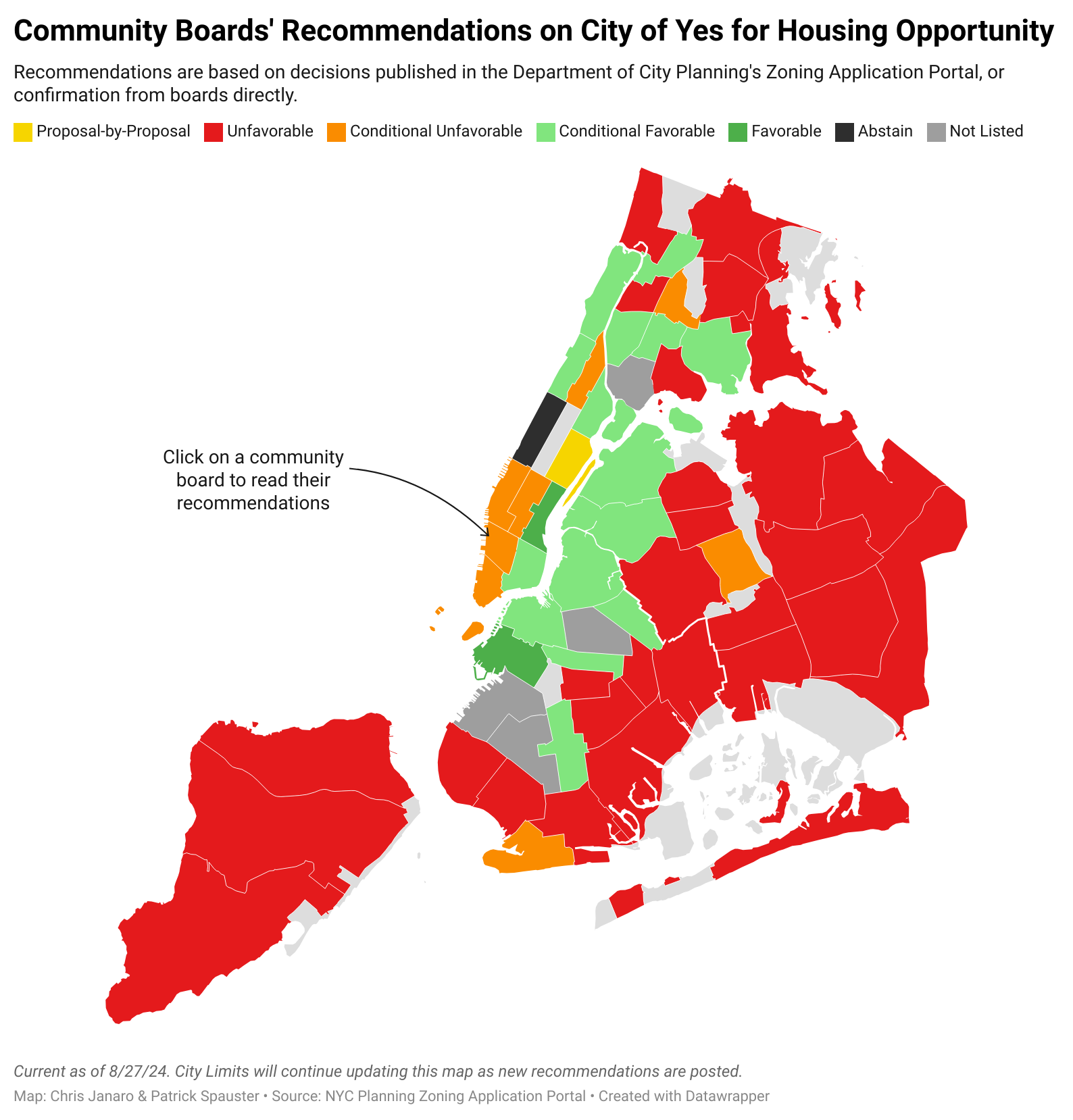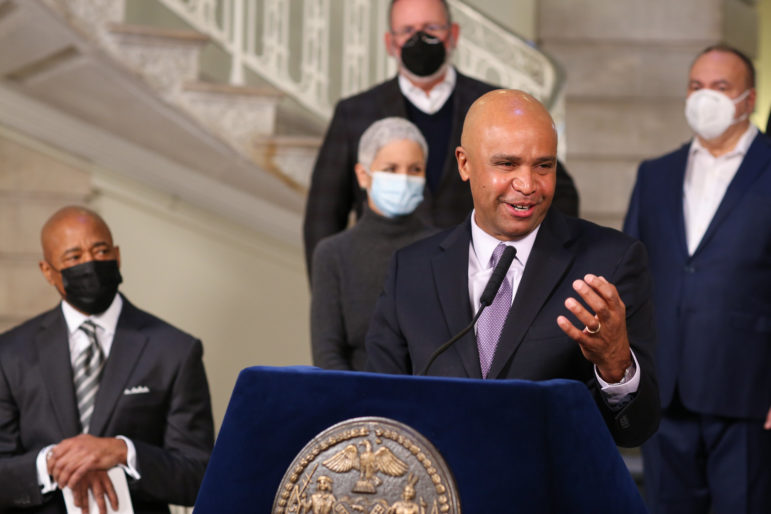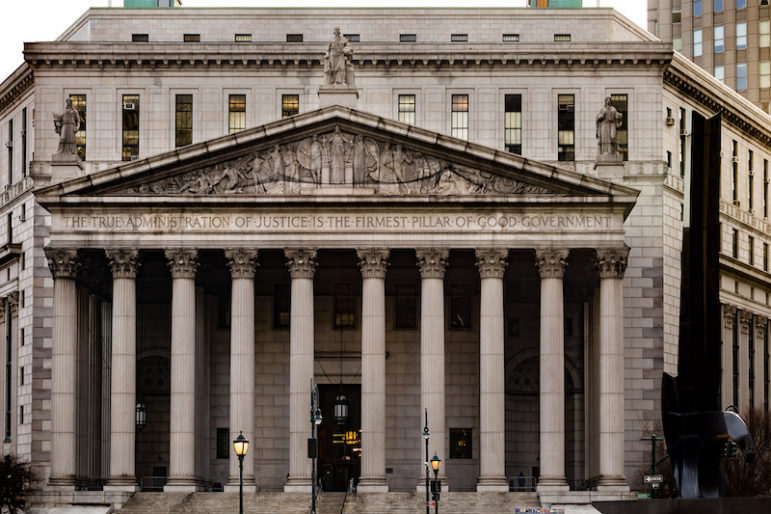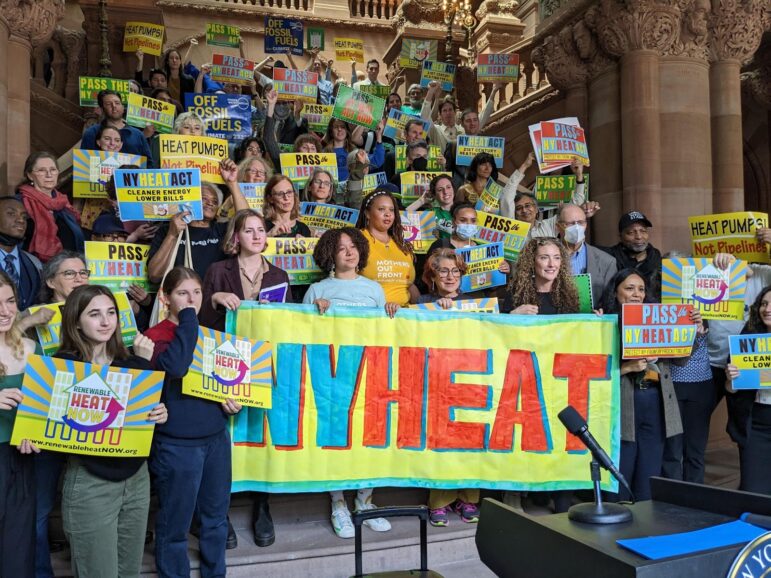“I think those of us who have homes should think about those who don’t have homes,” Mayor Eric Adams said in a recent push for his housing plan. “Far too many New Yorkers can’t afford to live in the city and we don’t have the housing stock that we need.”

Editor’s note: This story has been updated since original publication to reflect new community board recommendations published in the city’s online zoning application portal, and to include links to each board’s written comments accompanying their decisions.
Financing more housing units in the city is core to rebuilding New York’s economy and ensuring New Yorkers have affordable places to live, according to Mayor Eric Adams.
The remarks, at the administration’s weekly press briefing with reporters at the end of July, were part of Adams ongoing bid for his City of Yes for Housing Opportunity (COYFHO) plan, which aims to build more apartments and a wider variety of housing types in every neighborhood through a series of zoning reforms.
“We need to acknowledge that we are in a housing crisis,” Adams said. “I think those of us who have homes should think about those who don’t have homes. Far too many New Yorkers can’t afford to live in the city and we don’t have the housing stock that we need in the city. And we have to build more houses.”
But the plan—which would allow for additional residential density for developers who build affordable housing, more units near transit stations and above commercial shops, among other changes—has drawn mixed reactions as it weaves its way through the public review process.
So far, 28 of the city’s 59 community boards have issued “unfavorable” recommendations on the proposal, another two have issued “favorable” decisions and 16 others favorable “with conditions”―meaning the boards were generally supportive, but disagreed with certain aspects―according to votes published on the Department of City Planning’s (DCP) online portal.
Another six* boards weighed in unfavorably “with conditions,” while two Manhattan boards, CB7 and 8, abstained from giving a formal vote one way or the other, according to DCP. They instead opted to fill out a “component-by-component” worksheet indicating the specific aspects of the plan that they found favorable and unfavorable.
Current as of 8/27/24.
In previous interviews with City Limits, critics of the sweeping plan raised concerns about retaining current neighborhood character and allowing more as-of-right development outside of the public review process, while some have called for more stringent affordable rent requirements.
But supporters of the changes, including Adams’ administration officials, say it’s a crucial step to filling the city’s affordable housing shortage. The city’s rental vacancy rate last year stood at a historic low of 1.4 percent. For apartments costing less than $1,100 per month, the vacancy rate was even more severe, at just 0.39 percent. Meanwhile, the city’s homeless population has climbed.
“The 1.4 percent vacancy rate that we face is one that requires not small plans, not incremental plans, but the type of dramatic change that is progress, that is needed,” Maria Torres-Springer, the deputy mayor for housing, economic development and workforce, said Tuesday.
Should it pass, COYFHO would spur an estimated 100,000 new homes, she said. Five neighborhood rezoning plans the administration is pursuing—including in central Brooklyn, Jamaica, Queens, and near planned MetroNorth train stations in the Bronx—are expected to create another 50,000 apartments.
The planned units are double the residential capacity that was created in the entire 12-year term of former Mayor Mike Bloomberg, Torres-Springer claimed, and more than four times the capacity built in the eight years of Bill de Blasio.
She cited data from the latest census about the many New Yorkers struggling to afford a place to live—including on Staten Island, where all three community boards and the borough president have weighed in against the City of Yes proposal.
“In Staten Island, 53.9 percent of units of households are rent burdened, meaning that they pay more than 30 percent of their income on rent. And 30 percent are severely rent burdened meaning that they pay more than 50 percent of their income in rent,” Torres-Springer said.
Officials did tout some recent gains in affordable housing production: In fiscal year 2024, which ended June 30, city agencies financed the creation or preservation of nearly 29,000 income-restricted units, a record high, the mayor announced Monday. That number includes 14,706 newly constructed homes, 2,155 in supportive housing units, and 3,678 renovated apartments at NYCHA, the administration said.
Still, development happens unevenly—since 2014, affordable housing production was concentrated in just a handful of the city’s 51 Council districts, many of which were already high-density neighborhoods with higher populations of people of color.
COYFHO proposes addressing this by, as Mayor Adams puts it, “a little more housing in every neighborhood.”
“We are looking forward to engaging across the five boroughs, to working with the City Council so this gets over the finish line by the end of the year,” said Torres-Springer.
*This story was updated on Aug. 21, 2024 to reflect new community board decisions posted in the city's zoning application portal.
To reach the reporters behind this story, contact Chris@citylimits.org and Subeksha@citylimits.org. To reach the editor, contact Jeanmarie@citylimits.org
Want to republish this story? Find City Limits’ reprint policy here.









5 thoughts on “Tracking Community Boards’ Feedback on City of Yes for Housing”
The map showing the number of affordable units created from 2014 to 2023 is interesting but paints a very incomplete picture. What would be helpful to compare is a map showing the number of total housing units created during the same time period. This will then show the relationship between the number of units created and the number of those units that are affordable. Given that the City of Yes proposal seeks to increase the number of housing units with minimal requirements for affordable housing, this second map would show where developers are most likely to develop if given the chance to do so without an affordable housing requirement.
Please update map. CB1 voted No with conditions on COYHO.
Hi there, which borough are you referencing — Bronx CB1? It’s still not listed in the Dept. of City Planning portal. If you’re a member of the board who can confirm the vote/share a copy of the board’s recommendation, we’d be grateful; please email editor jeanmarie@citylimits.org. Thank you!
I’m a homeowner in Richmond hill/ Kew gardens Queens. Developers in my immediate area have built 12 apartments buildings recently. NONE ARE so called affordable! They are built with foreign money with Non union substandard labor. The workers are not from the area, they bring in their own food vendors from coolers out of vans. They do not patronize the local delicatessens or restaurants, they trash the streets with garbage and clog our sewers with concrete sludge. They also abuse the department of buildings inability to inspect the sites to check that they are within building lot lines. It’s all about greed. If they change the zoning rules hard working individuals will be further pushed out. Landlords with multiple dwelling units rather have them empty because tenants take advantage and squat for months sometimes years without paying rent. The mayor wants to shine politically, “scuttle the ship” and he will move on leaving destruction in his wake.
Queens opposed to City of Yes (City of Mess)! – http://u.pc.cd/gyDrtalK
Staten Island opposed to City of Yes (City of Mess)! – http://u.pc.cd/8p5otalK
The biggest hypocrite in the entire ‘City of Yes’ process is City Planning boss Dan Garodnick. Hypocrite Dan Garodnick lives in a $2.4M co-op in the ‘Upper West Side / Central Park West
Historic District’. His home will NOT be impacted by City of Yes. Yet he wants to destroy the neighborhoods of New Yorkers who own homes worth a quarter of his home.
From public Acris records – https://a836-acris.nyc.gov/DS/DocumentSearch/DocumentDetail?doc_id=2021020301319001